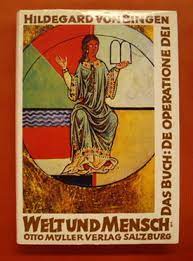It was an important task in life to bring this concern to broad attention. ‘Don’t call me an environmental activist, call me an earth creator!’, she said with a determination that brooked no contradiction.
It was as if an ancient past suddenly broke through in the present on the train journey. Was it not the German seeress and femina universalis Hildegard von Bingen (1098-1178) who saw man’s most important task as being a co-creator in this creation? Indeed! The prophetess from Bingen wrote in Scivias (Know the Ways) that man does not exist for himself but has the task of completing the work of creation. Man is not only a creature but also a creator. In him/her creature and creation flow together or, in her terms microcosm and macrocosm.
With this approach, she touches on the concept of health. In images of the ‘life green’ (the viriditas) she shows what she means by it. Health is not a state, abstract value, or inner or social feeling of well-being. Hildegard shows a deeper way of unity and wholeness between body and mind.
The soul is the greening life force that makes the body grow.
That life force enables man to work on his/her divine assignment to be a co-creator. That is true health!
That green life force flows in from the Green Sophia, the female other half of God, the All-Mother or Lady Nature. The visions of the feminine of the creation event that Hildegard wrote down in 1151 have long been dismissed as curiosities. However, also from the science of that time, there are now signals that the creation has been dominated by the female. The monk Bernard Silvestris from Tours, France, wrote an unknown creation story ‘The cosmos written’ (1147). Silvestris invoked, among others, Plato, Boethius and the Corpus Hermeticum, especially the Asclepius. In the first part, ‘Megacosmos’, it appears that Lady Nature is tired of the material chaos and begs the Lady Spirit to create an orderly and more beautiful cosmos. Spirit then separates the elements of fire, water, earth and air, the angels, stars, planets and winds. Then she provides the earth with mountains, rivers, plants and animals. She saves the highlight for last: the creation of the microcosm.
After Hildegard, the Green Sophia has gone underground again for a long time. It is remarkable that the Earth is less well off when the green Sophia or the All-Mother is pushed out of consciousness. That was already in archaic times. Then there is scarcity and famine. Then the earth threatens to degenerate into a stinging aridity, into a dead thing that you can exploit for your own gain. However, as a broad awakening of consciousness seems to be growing, devotion to the creative feminine goddess and to Mother Earth is gradually returning.
Here is a beatitude from the Sermon on the Mount:
Blessed are the meek, for they shall inherit the earth.
The meek (beautiful word!) embody the awakened consciousness that is changing all aspects of life on our planet and also nature, because life on earth is inextricably linked to the human consciousness that sees it and acts on it. That is inheriting the earth.
Being born is an assignment! A command to awaken and to be meek. Of course, you can also show this by going to a demonstration, but it is, above all, an inner process.
Asclepius is known for a hymn to man. Hermes says in it:
Therefore, Asclepius, man is a great marvel, a being worthy of adoration and reverence. After all, he transforms into a divine nature as if he were a god himself, he knows the class of demons by realizing that he has the same origin as them, and he looks down on that part of him which is of human nature, trusting on the divinity of his other part.
Quoted from: Silvestris, Bernard, The Cosmos written, a twelfth-century creation story, translated from Latin by Piet Gerbrandy, Damon Eindhoven 2022, p. 25
The Word of God is in all creation.
No creature has meaning without the word of God. God’s word is in all created things, visible and invisible. The word is life, being, spirit, ever lush green, ever creating.
This word radiates in every creature. This is how the spirit joins the body – the word is inseparable from God.
Hildegard von Bingen
Quoted from: Teachings of the Christian Mystics, edited by Andrew Harvey, Shambala Publications, Boston 1998, 80.

Image: Green Sophia
From: Hildegardis Bingensis: Liber divinorum operum, [The Book of Divine Works], Brepols, Turnhout, 1996


